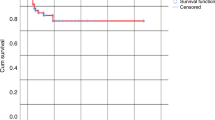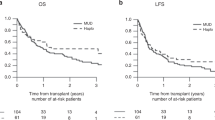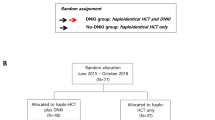Summary:
We treated 17 patients with refractory (n=7) or relapsed lymphoid malignancy (n=10) following allogeneic HSCT with donor lymphocyte infusions (DLI). Patients with low-grade disease received DLI alone (n=7) or following radiotherapy (n=1). Patients with aggressive disease (n=9) received prior chemotherapy. Nine out of 15 patients receiving DLI from sibling donors responded after one (n=6), two (n=2) and three (n=1) infusions. Both MUD recipients achieved CR after two and three DLI. In all, 10/17 patients achieved CR including 3/4 patients with chronic lymphatic leukaemia (CLL), 4/4 with mantle cell lymphoma (MCL), 3/4 with follicular NHL but 0/5 with aggressive NHL/Richters. The median CD3 cell dose to achieve CR for siblings was 2 × 107/kg. One patient with CLL had a second transplant following DLI-induced aplasia and is in CR at 14 months giving a final CR rate of 64%. Grade II–IV acute GVHD developed in 45% and chronic GVHD in 8/9 evaluable patients. Of the 11 patients finally achieving CR, one patient with MCL relapsed at 18 months post-DLI but all others remain in remission with a median follow-up of 40 months (range 12–64 months). Low-grade NHL and MCL have a high response rate and sustained remissions following DLI. Aggressive disease responds poorly however, despite pre-DLI chemotherapy.
This is a preview of subscription content, access via your institution
Access options
Subscribe to this journal
Receive 12 print issues and online access
$259.00 per year
only $21.58 per issue
Buy this article
- Purchase on Springer Link
- Instant access to full article PDF
Prices may be subject to local taxes which are calculated during checkout


Similar content being viewed by others
References
van Besien K, Loberiza Jr FR, Bajorunaite R et al. Comparison of autologous and allogeneic hematopoietic stem cell transplantation for follicular lymphoma. Blood 2003; 102: 3521–3529.
Robinson SP, Goldstone AH, Mackinnon S et al. Chemoresistant or aggressive lymphoma predicts for a poor outcome following reduced-intensity allogeneic progenitor cell transplantation: an analysis from the Lymphoma Working Party of the European Group for Blood and Bone Marrow Transplantation. Blood 2002; 100: 4310–4316.
Marks DI, Lush R, Cavenagh J et al. The toxicity and efficacy of donor lymphocyte infusions given after reduced-intensity conditioning allogeneic stem cell transplantation. Blood 2002; 100: 3108–3114.
Bethge WA, Hegenbart U, Stuart MJ et al. Adoptive immunotherapy with donor lymphocyte infusions after allogeneic hematopoietic cell transplantation following nonmyeloablative conditioning. Blood 2004; 103: 790–795.
Peggs KS, Thomson K, Hart DP et al. Dose-escalated donor lymphocyte infusions following reduced intensity transplantation: toxicity, chimerism, and disease responses. Blood 2004; 103: 1548–1556.
Mandigers CM, Verdonck LF, Meijerink JP et al. Graft-versus-lymphoma effect of donor lymphocyte infusion in indolent lymphomas relapsed after allogeneic stem cell transplantation. Bone Marrow Transplant 2003; 32: 1159–1163.
Morris E, Thomson K, Craddock C et al. Outcomes after alemtuzumab-containing reduced-intensity allogeneic transplantation regimen for relapsed and refractory non-Hodgkin lymphoma. Blood 2004; 104: 3865–3871.
Dreger P, Brand R, Hansz J et al. Treatment-related mortality and graft-versus-leukemia activity after allogeneic stem cell transplantation for chronic lymphocytic leukemia using intensity-reduced conditioning. Leukemia 2003; 17: 841–848.
Cull GM, Haynes AP, Byrne JL et al. Preliminary experience of allogeneic stem cell transplantation for lymphoproliferative disorders using BEAM-CAMPATH conditioning: an effective regimen with low procedure-related toxicity. Br J Haematol 2000; 108: 754–760.
Faulkner RD, Craddock C, Byrne JL et al. BEAM-alemtuzumab reduced-intensity allogeneic stem cell transplantation for lymphoproliferative diseases: GVHD, toxicity, and survival in 65 patients. Blood 2004; 103: 428–434.
Glucksberg H, Storb R, Fefer A et al. Clinical manifestations of graft-versus-host disease in human recipients of marrow from HL-A-matched sibling donors. Transplantation 1974; 18: 295–304.
Shulman HM, Sullivan KM, Weiden PL et al. Chronic graft-versus-host syndrome in man. A long-term clinicopathologic study of 20 Seattle patients. Am J Med 1980; 69: 204–217.
Corradini P, Dodero A, Zallio F et al. Graft-versus-lymphoma effect in relapsed peripheral T-cell non-Hodgkin's lymphomas after reduced-intensity conditioning followed by allogeneic transplantation of hematopoietic cells. J Clin Oncol 2004; 22: 2172–2176.
Khouri IF, Lee MS, Saliba RM et al. Nonablative allogeneic stem-cell transplantation for advanced/recurrent mantle-cell lymphoma. J Clin Oncol 2003; 21: 4407–4412.
Maris MB, Sandmaier BM, Storer BE et al. Allogeneic hematopoietic cell transplantation after fludarabine and 2 Gy total body irradiation for relapsed and refractory mantle cell lymphoma. Blood 2004; 104: 3535–3542.
Kottaridis PD, Milligan DW, Chopra R et al. In vivo CAMPATH-1H prevents graft-versus-host disease following nonmyeloablative stem cell transplantation. Blood 2000; 96: 2419–2425.
Author information
Authors and Affiliations
Corresponding author
Rights and permissions
About this article
Cite this article
Russell, N., Byrne, J., Faulkner, R. et al. Donor lymphocyte infusions can result in sustained remissions in patients with residual or relapsed lymphoid malignancy following allogeneic haemopoietic stem cell transplantation. Bone Marrow Transplant 36, 437–441 (2005). https://doi.org/10.1038/sj.bmt.1705074
Received:
Accepted:
Published:
Issue Date:
DOI: https://doi.org/10.1038/sj.bmt.1705074
Keywords
This article is cited by
-
Prognostic value of pre-transplantation total metabolic tumor volume on 18fluoro-2-deoxy-d-glucose positron emission tomography–computed tomography in relapsed and refractory aggressive lymphoma
International Journal of Hematology (2022)
-
Immunotherapy with FBTA05 (Bi20), a trifunctional bispecific anti-CD3 x anti-CD20 antibody and donor lymphocyte infusion (DLI) in relapsed or refractory B-cell lymphoma after allogeneic stem cell transplantation: study protocol of an investigator-driven, open-label, non-randomized, uncontrolled, dose-escalating Phase I/II-trial
Journal of Translational Medicine (2013)
-
The outcome of reduced intensity allogeneic stem cell transplantation and autologous stem cell transplantation when performed as a first transplant strategy in relapsed follicular lymphoma: an analysis from the Lymphoma Working Party of the EBMT
Bone Marrow Transplantation (2013)
-
Genetic Modification of T Cells Improves the Effectiveness of Adoptive Tumor Immunotherapy
Archivum Immunologiae et Therapiae Experimentalis (2010)
-
Stem Cell Transplantation in Childhood Non-Hodgkin’s Lymphomas
Current Hematologic Malignancy Reports (2010)



